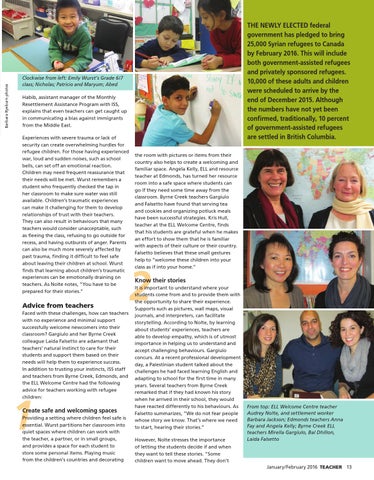Barbara Ryeburn photos
THE NEWLY ELECTED federal government has pledged to bring 25,000 Syrian refugees to Canada by February 2016. This will include both government-assisted refugees and privately sponsored refugees. 10,000 of these adults and children were scheduled to arrive by the end of December 2015. Although the numbers have not yet been confirmed, traditionally, 10 percent of government-assisted refugees are settled in British Columbia.
Clockwise from left: Emily Wurst’s Grade 6/7 class; Nicholas; Patricio and Maryum; Abed
Habib, assistant manager of the Monthly Resettlement Assistance Program with ISS, explains that even teachers can get caught up in communicating a bias against immigrants from the Middle East. Experiences with severe trauma or lack of security can create overwhelming hurdles for refugee children. For those having experienced war, loud and sudden noises, such as school bells, can set off an emotional reaction. Children may need frequent reassurance that their needs will be met. Wurst remembers a student who frequently checked the tap in her classroom to make sure water was still available. Children’s traumatic experiences can make it challenging for them to develop relationships of trust with their teachers. They can also result in behaviours that many teachers would consider unacceptable, such as fleeing the class, refusing to go outside for recess, and having outbursts of anger. Parents can also be much more severely affected by past trauma, finding it difficult to feel safe about leaving their children at school. Wurst finds that learning about children’s traumatic experiences can be emotionally draining on teachers. As Nolte notes, “You have to be prepared for their stories.”
Advice from teachers Faced with these challenges, how can teachers with no experience and minimal support successfully welcome newcomers into their classroom? Gargiulo and her Byrne Creek colleague Laida Falsetto are adamant that teachers’ natural instinct to care for their students and support them based on their needs will help them to experience success. In addition to trusting your instincts, ISS staff and teachers from Byrne Creek, Edmonds, and the ELL Welcome Centre had the following advice for teachers working with refugee children:
1
Create safe and welcoming spaces Providing a setting where children feel safe is essential. Wurst partitions her classroom into quiet spaces where children can work with the teacher, a partner, or in small groups, and provides a space for each student to store some personal items. Playing music from the children’s countries and decorating
the room with pictures or items from their country also helps to create a welcoming and familiar space. Angela Kelly, ELL and resource teacher at Edmonds, has turned her resource room into a safe space where students can go if they need some time away from the classroom. Byrne Creek teachers Gargiulo and Falsetto have found that serving tea and cookies and organizing potluck meals have been successful strategies. Kris Hull, teacher at the ELL Welcome Centre, finds that his students are grateful when he makes an effort to show them that he is familiar with aspects of their culture or their country. Falsetto believes that these small gestures help to “welcome these children into your class as if into your home.”
2
Know their stories It is important to understand where your students come from and to provide them with the opportunity to share their experience. Supports such as pictures, wall maps, visual journals, and interpreters, can facilitate storytelling. According to Nolte, by learning about students’ experiences, teachers are able to develop empathy, which is of utmost importance in helping us to understand and accept challenging behaviours. Gargiulo concurs. At a recent professional development day, a Palestinian student talked about the challenges he had faced learning English and adapting to school for the first time in many years. Several teachers from Byrne Creek remarked that if they had known his story when he arrived in their school, they would have reacted differently to his behaviours. As Falsetto summarizes, “We do not fear people whose story we know. That’s where we need to start, hearing their stories.” However, Nolte stresses the importance of letting the students decide if and when they want to tell these stories. “Some children want to move ahead. They don’t
From top: ELL Welcome Centre teacher Audrey Nolte, and settlement worker Barbara Jackson; Edmonds teachers Anna Fay and Angela Kelly; Byrne Creek ELL teachers Mirella Gargiulo, Bal Dhillon, Laida Falsetto
January/February 2016 TEACHER 13
